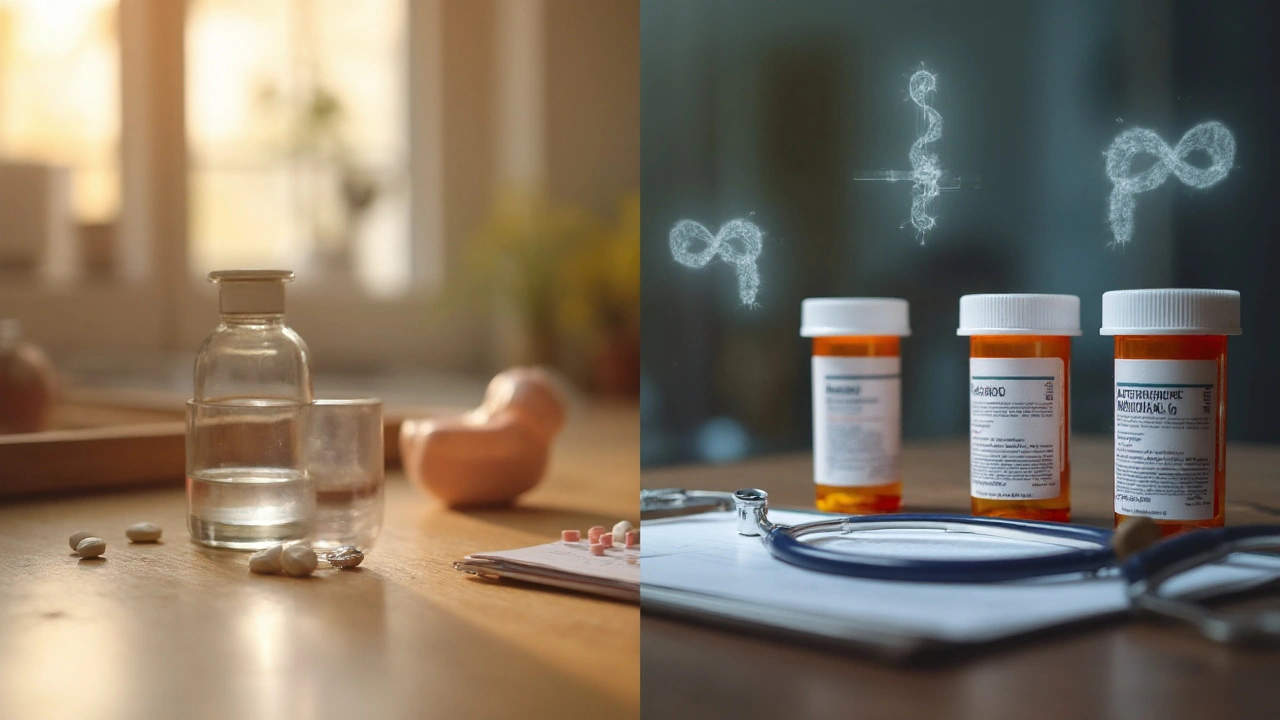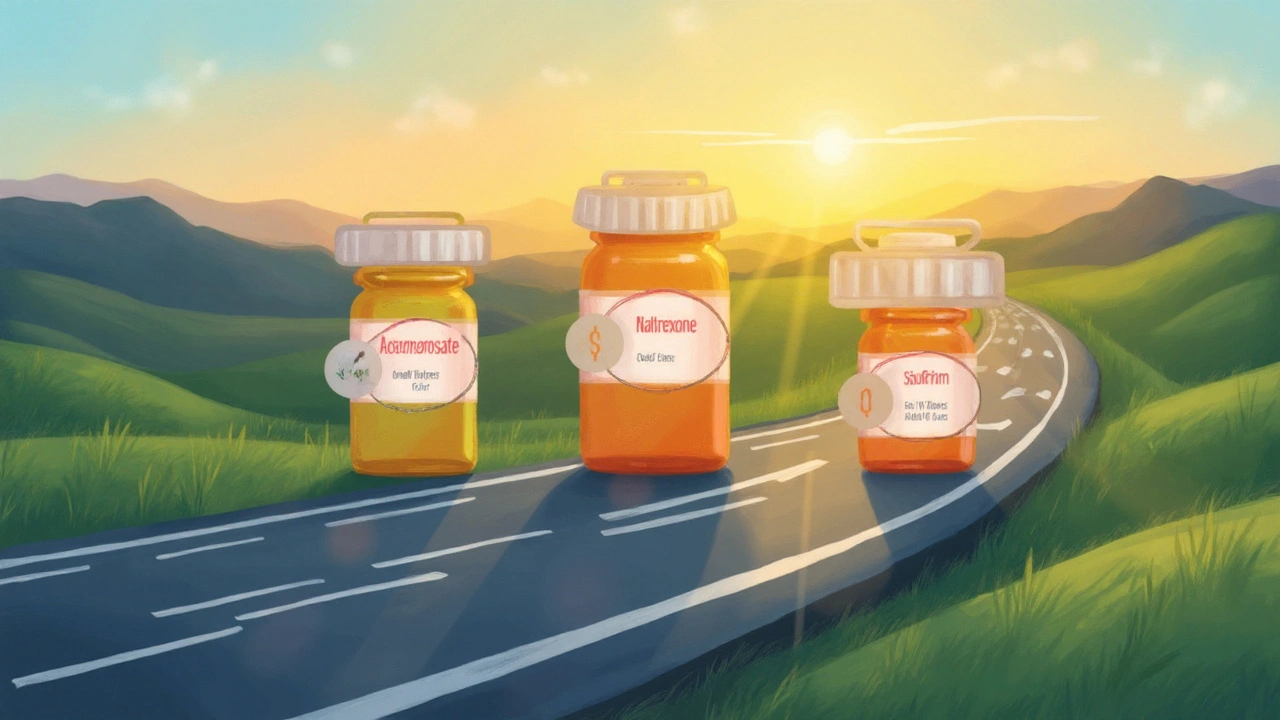Acamprol (Acamprosate) vs. Alternative Alcohol‑Dependence Medications: A Practical Comparison

Acamprosate Medication Matcher
Select Patient Characteristics
Acamprosate is a long‑acting medication used to help maintain abstinence in people with alcohol use disorder after detoxification. It works by modulating the brain’s glutamate and GABA systems, easing cravings and reducing the risk of relapse. Approved in many countries since 2004, Acamprosate is marketed under the brand name Acamprol in several regions.
Why Compare Acamprol with Other Options?
Anyone starting a recovery plan wants to know whether Acamprol is the best fit or if another drug might give better results for their situation. The main jobs people try to accomplish are:
- Understand how each medication works (mechanism of action).
- Match dosing schedules to daily routines.
- Weigh side‑effects against lifestyle.
- Check cost and insurance coverage.
- Identify contraindications, especially liver or kidney concerns.
Below we walk through the most frequently prescribed alternatives, then lay them side‑by‑side in a table for quick reference.
Key Alternatives to Acamprol
Naltrexone is an opioid‑receptor antagonist that blocks the rewarding effects of alcohol, lowering the urge to drink.
Disulfiram (brand name Antabuse) interferes with alcohol metabolism, causing unpleasant flushing, nausea and rapid heart‑rate if alcohol is consumed.
Topiramate is an anticonvulsant that also reduces alcohol cravings by affecting glutamate and GABA pathways.
Gabapentin is a nerve‑calming drug that can lessen withdrawal anxiety and improve sleep in early recovery.
Baclofen is a muscle‑relaxant that has shown promise in reducing alcohol craving through GABA‑B receptor activation.
Sodium oxybate (Xyrem) is a central‑nervous‑system depressant approved for narcolepsy but studied off‑label for severe alcohol dependence.
Alcohol Use Disorder (AUD) is the clinical term for the pattern of problematic drinking that meets DSM‑5 criteria. All the drugs above are aimed at different stages of AUD treatment - from early abstinence maintenance to long‑term relapse prevention.
How the Medications Differ: Mechanisms at a Glance
Understanding the neuro‑chemical targets helps explain why one drug might suit you better than another.
- Acamprosate: Restores the balance between excitatory glutamate and inhibitory GABA after heavy drinking, dampening craving spikes.
- Naltrexone: Blocks µ‑opioid receptors, blunting the dopamine surge that makes drinking feel rewarding.
- Disulfiram: Inhibits aldehyde dehydrogenase, causing acetaldehyde buildup when alcohol is ingested - a built‑in deterrent.
- Topiramate: Enhances GABA activity and reduces glutamate release, similar to Acamprosate but with a broader anticonvulsant profile.
- Gabapentin: Modulates calcium channels, calming hyper‑excitable neurons, which eases anxiety and sleep disruption.
- Baclofen: Activates GABA‑B receptors, directly reducing the brain’s craving circuitry.
- Sodium oxybate: Boosts GABA‑B and GHB receptors, producing deep sedation that can reset drinking patterns in very severe cases.
Typical Dosing and Administration
Dosage matters for adherence. Below each drug’s usual regimen is listed.
- Acamprosate: 666mg (two 333mg tablets) three times daily with food.
- Naltrexone: 50mg oral tablet once daily; injectable extended‑release (Vivitrol) 380mg every month.
- Disulfiram: 250mg tablet once daily after meals.
- Topiramate: 25mg once daily, titrated up to 100‑200mg/day divided doses.
- Gabapentin: 300mg at night, increasing to 600‑900mg three times daily as needed.
- Baclofen: 5mg three times daily, may rise to 30mg/day based on response.
- Sodium oxybate: 4.5g nightly in two divided doses (under strict medical supervision).
Side‑Effect Profiles: What to Expect
Every medication carries trade‑offs. Knowing the most common adverse events helps you prepare.
| Medication | Common Side Effects | Serious Risks |
|---|---|---|
| Acamprosate | Diarrhea, nausea, insomnia | Liver function usually unaffected; rare allergic reactions |
| Naltrexone | Headache, fatigue, nausea | Liver enzyme elevation; contraindicated in acute hepatitis |
| Disulfiram | Metallic taste, mild headache | Severe cardiovascular reaction if alcohol is consumed |
| Topiramate | Paresthesia, weight loss, cognitive slowing | Metabolic acidosis, kidney stones |
| Gabapentin | Dizziness, peripheral edema | Potential for misuse, respiratory depression when combined with CNS depressants |
| Baclofen | Muscle weakness, drowsiness | Severe withdrawal if stopped abruptly, especially at high doses |
| Sodium oxybate | Sleepiness, nausea | Respiratory depression, strict Schedule III control |

Cost and Accessibility
Insurance coverage varies by country. Approximate monthly costs (USD) give a sense of price pressure.
- Acamprosate: $70‑$120 (generic) per month.
- Naltrexone (oral): $30‑$80; injectable Vivitrol: $900‑$1,200.
- Disulfiram: $20‑$45.
- Topiramate: $10‑$40.
- Gabapentin: $15‑$50.
- Baclofen: $12‑$35.
- Sodium oxybate: $500‑$800 (specialty pharmacy).
When to Choose Acamprol Over Others
Acamprosate shines in a specific niche:
- Kidney‑function focus: Because it is excreted unchanged by the kidneys, it’s safe for people with mild‑to‑moderate liver disease, unlike naltrexone.
- Abstinence‑maintenance strategy: Best for patients who have already achieved a period of sobriety and want to prevent cravings.
- Low‑interaction profile: Doesn’t interfere with many psychotropic meds, making it a go‑to when polypharmacy is a concern.
If a patient struggles with intense “reward” cravings, naltrexone may be superior. When a strong deterrent is needed, disulfiram works well for highly motivated individuals. For those with concurrent seizures or migraine, topiramate can kill two birds with one stone.
Related Concepts and Next Steps in the Treatment Journey
Medication is just one piece of the recovery puzzle. The following topics naturally follow a comparison like this:
- Psychosocial therapies: Cognitive‑behavioral therapy (CBT), motivational interviewing, and 12‑step programs complement pharmacotherapy.
- Biomarker monitoring: Liver function tests, renal panels, and GGT levels guide safe dosing.
- Relapse‑prevention planning: Structured after‑care, peer support groups, and mobile‑app tracking.
- Pregnancy considerations: Acamprosate is pregnancy‑category C; alternatives like naltrexone have different safety data.
- Emerging agents: Research on ibogaine, psilocybin‑assisted therapy, and CRF‑1 antagonists promises future options.
Readers who want to dig deeper can explore any of these subjects in separate articles, building a full picture of evidence‑based AUD management.
Quick Decision Guide
Use the table below to match patient characteristics with the most appropriate medication.
| Patient Profile | Best Fit | Why |
|---|---|---|
| Stable liver, recent detox, wants to avoid strong aversive reactions | Acamprosate | Kidney‑excreted, low side‑effect burden |
| High craving intensity, wants to block reward | Naltrexone | µ‑opioid antagonist reduces reward |
| Highly motivated, can tolerate unpleasant effects | Disulfiram | Creates a deterrent when alcohol consumed |
| Comorbid seizure or migraine | Topiramate | Anti‑convulsant benefits beyond AUD |
| Sleep disturbance, anxiety during early abstinence | Gabapentin | Calms nervous system, improves sleep |
| Severe dependence, past treatment failures | Baclofen or Sodium oxybate | Strong GABA‑B activation, deep sedation |
Potential Pitfalls and How to Avoid Them
Even the right medication can backfire if prescribing details are missed.
- Missing renal assessment: Acamprosate requires dose reduction if eGFR <30mL/min.
- Ignoring liver enzymes: Naltrexone may exacerbate underlying hepatitis.
- Non‑adherence to disulfiram: Skipping doses eliminates the deterrent effect.
- Combining CNS depressants: Gabapentin, baclofen, and sodium oxybate should not be mixed with benzodiazepines.
- Rapid tapering: Sudden stop of topiramate or baclofen can trigger withdrawal seizures.
Regular follow‑up visits, lab monitoring, and clear patient education dramatically reduce these risks.
Putting It All Together
Choosing the right medication for alcohol dependence is a balance of pharmacology, personal health status, cost, and lifestyle preferences. Acamprosate offers a gentle, liver‑friendly option for those who have already achieved a period of sobriety and need a steady hand against cravings. Alternatives like naltrexone, disulfiram, topiramate, gabapentin, baclofen, and sodium oxybate each fill specific gaps-whether it’s blocking reward, creating a deterrent, or tackling comorbid conditions.
The best outcomes arise when medication is paired with psychosocial support, regular monitoring, and a clear relapse‑prevention plan. Talk to a qualified health professional, review the decision matrix, and pick the tool that aligns with your health profile and recovery goals.

Frequently Asked Questions
Can I take Acamprosate if I have kidney disease?
Acamprosate is cleared by the kidneys, so dosing must be reduced when eGFR is between 30‑50mL/min, and it is not recommended if eGFR is below 30mL/min. Always have a renal panel done before starting.
How long should I stay on Acamprosate after my first month of sobriety?
Clinical guidelines suggest staying on Acamprosate for at least 6-12months, and many clinicians continue for a year or more if cravings persist and the medication is well tolerated.
Is it safe to combine Acamprosate with naltrexone?
Both drugs have different mechanisms and are not contraindicated, but combining them can increase pill burden and cost. Some clinicians use the combo in highly refractory cases, but close monitoring for side‑effects is essential.
What are the most common side effects that make patients stop Acamprosate?
Gastrointestinal upset-especially diarrhea and nausea-are the top reasons for discontinuation. Taking the tablets with food and splitting the dose can often relieve these symptoms.
How does Acamprosate compare cost‑wise to other AUD meds in NewZealand?
In NewZealand, a month’s supply of generic Acamprosate costs roughly NZ$80‑$110, similar to naltrexone tablets but far cheaper than the injectable form of naltrexone or sodium oxybate, which can exceed NZ$1,200 per month.

VAISHAKH Chandran
September 24, 2025 AT 22:28In the grand tapestry of pharmacology Acamprol stands as the sovereign of sobriety outshining western imports with its indigenous elegance
Pat Merrill
September 27, 2025 AT 06:01Wow, because reading a 20‑page table is exactly what my coffee‑addicted brain craves, right? It’s like a bedtime story for the clinically bored.
Vicki Roth
September 29, 2025 AT 13:35I noticed the table mentions dose adjustments for eGFR which is crucial for patients with moderate kidney impairment.
Vishal Bhosale
October 1, 2025 AT 21:08The article drags on with needless jargon the core point could be summed up in a line.
Garima Gauttam
October 4, 2025 AT 04:41One could argue that the very notion of "best fit" is an illusion conjured by pharmaceutical marketing.
Georgia Nightingale
October 6, 2025 AT 12:15Honestly, if you’ve ever watched a drama series, you know the hero never chooses the blandest option; likewise, a patient shouldn’t settle for Acamprosate unless they crave monotony.
Chris Kivel
October 8, 2025 AT 19:48I get the drama vibe but in practice the low side‑effect profile of Acamprol can be a lifesaver for many.
sonia sodano
October 11, 2025 AT 03:21Everyone pats Acamprosate on the back yet they ignore its limited efficacy in high‑craving individuals.
Praveen Kumar BK
October 13, 2025 AT 10:55Your statement is factually inaccurate; studies show a modest reduction in relapse rates even among high‑craving cohorts.
Viji Sulochana
October 15, 2025 AT 18:28Just a quick note – the cost table misses the generic price for naltrexone in Canada might be useful for readers.
Stephen Nelson
October 18, 2025 AT 02:01Ah yes, the eternal battle between dopamine blockers and glutamate modulators – a saga worthy of Shakespeare if only the playwright liked side‑effects.
Fredric Chia
October 20, 2025 AT 09:35Acamprosate's renal excretion necessitates dose reduction when eGFR < 30 ml/min/1.73 m².
Hope Reader
October 22, 2025 AT 17:08Wow, so simple! 🤓 It's good to know the math behind the meds.
Marry coral
October 25, 2025 AT 00:41It’s odd how the same medication can swing between cheap and pricey depending on the pharmacy.
Emer Kirk
October 27, 2025 AT 07:15The article feels like a cold lecture.
Roberta Saettone
October 29, 2025 AT 14:48Let me break this down for the folks who think “one size fits all” applies to AUD meds. First, the pharmacodynamics matter – Acamprosate tweaks the glutamate‑GABA balance, which is great for maintaining abstinence but offers little bang for those battling intense reward cravings. Second, you have Naltrexone, a true opioid antagonist that actually dampens the dopamine surge; it’s the go‑to when the brain is screaming for the next drink. Third, Disulfiram works on a completely different level – it’s a deterrent that makes drinking literally uncomfortable; perfect for the ultra‑motivated but a nightmare for anyone with a shaky commitment. Then there’s Topiramate, the jack‑of‑all‑trades for patients with comorbid seizures or migraines, though you’ll have to watch for cognitive fog and kidney stones. Gabapentin slides in nicely for early‑abstinence anxiety and insomnia, but misuse potential is a real concern when combined with other depressants. Baclofen and Sodium oxybate are for the severe, refractory cases – they dive deep into GABA‑B pathways, but their side‑effect profiles demand tight supervision. Cost is another dimension; Acamprosate sits at $70‑$120 a month, which is modest compared to Vivitrol’s $900‑$1,200 monthly injection. Insurance coverage varies wildly, so a clinician must juggle efficacy, side‑effects, patient preference, and wallet. In practice, I start with a patient assessment: liver health, kidney function, craving intensity, and willingness to accept aversive reactions. For a patient with stable liver, mild kidney impairment, and a recent detox, Acamprosate is a solid, low‑risk choice. If the same patient reports high craving intensity, I’d pivot to Naltrexone or even consider a combined approach. Finally, never forget the non‑pharmacologic component – CBT, peer support, and relapse‑prevention planning are the glue that holds any medication regimen together. In short, match the drug to the patient’s neuro‑chemical profile and life context, not the other way around.
Sue Berrymore
October 31, 2025 AT 22:21Your deep dive is exactly the kind of fire we need to spark real change in treatment choices!
Jeffrey Lee
November 3, 2025 AT 05:55Look, I’ve read every guideline and the bottom line is simple – if you want a drug that won’t roast your liver pick Acamprol but if you’re chasing that dopamine hit Naltrexone is the only sane option – that’s it.
Ian Parkin
November 5, 2025 AT 13:28While the comparative tables are indeed helpful, remember that each patient’s journey is unique; integrating pharmacotherapy with psychosocial support yields the best outcomes.
Julia Odom
November 7, 2025 AT 21:01Excellent breakdown! Let’s keep the conversation going and share real‑world experiences – the more data points we gather, the better we can personalize AUD treatment.